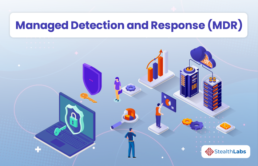The cyber landscape is ever-evolving. Increasing adoption of technologies, like cloud, AI, and IoTs, although positive, is further complicating the landscape. As a result, the traditional approach to IT security has become obsolete to secure an organization’s critical assets or manage threats.
Although, many organizations are cognizant of evolving security demands, they lack the required expertise, resources, and intelligence to manage the complexities of enterprise security. This is where Managed Detection and Response (MDR) Services comes into the picture.
What is Managed Detection and Response (MDR)?
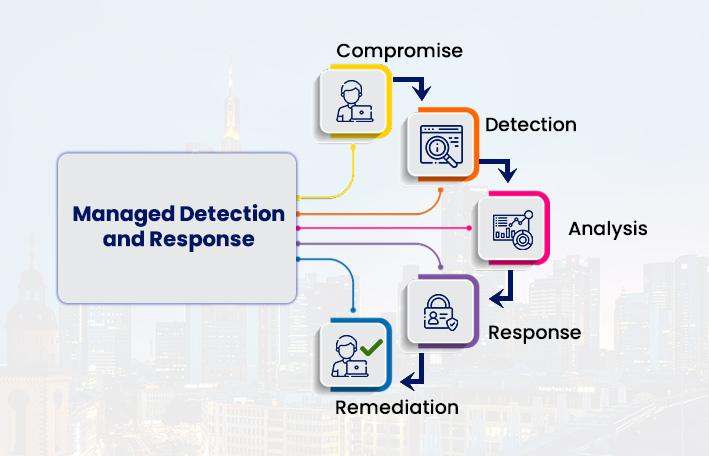
MDR is a service which provides an organization with the tools to effectively identify, analyze, and respond to cyber threats, before they disrupt the business. By partnering with an MDR service provider like StealthLabs, an organization gains 24/7 access to sophisticated technologies and security expertise to embrace advanced threat defense. With MDR, organizations can proactively detect and deftly respond to threats.
What Security Challenges Does MDR Mitigate?
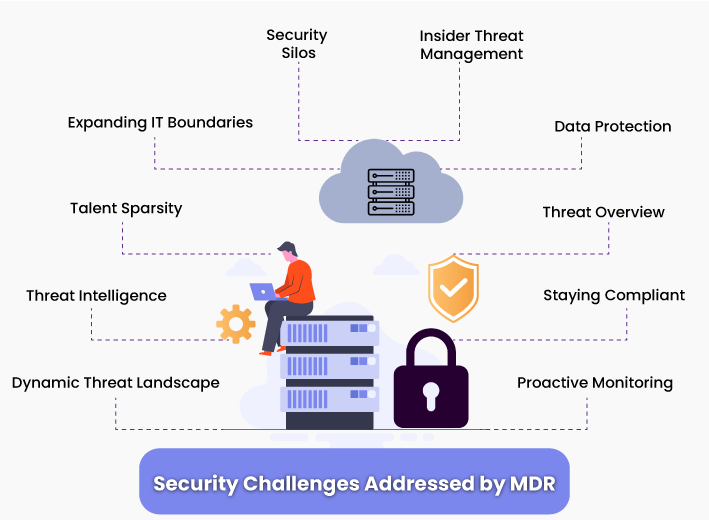
Managed detection and response is a panacea to many of the challenges faced by enterprises endeavoring to improve cybersecurity maturity, such as:
1) Dynamic Threat Landscape
With the proliferation of digital technologies, including IoT, AI, and ML, the threat landscape is evolving and expanding significantly. MDR brings the right technologies and expertise to identify the relevant, current, and emerging threats to your business and proactively mitigates them.
2) Threat Intelligence
By differentiating real threats and false alarms, MDR service provider drafts an effective strategy to respond and remediate qualified incidents. This aspect is one of the most significant challenges faced by enterprises. MDR tailors this vital advanced threat defense through a combination of sophisticated threat monitoring technologies and threat intelligence.
3) Talent Sparsity
Building and maintaining the relevant security infrastructure, intelligence, and expertise is challenging for many organizations. MDR enables organizations to fill the security gaps, helping them become more secure, vigilant, and resilient. MDR service providers offer the required expertise and resources to swat away threats.
4) Expanding IT Boundaries
As business expand their IT boundaries by moving to the cloud, staying vigilant for emerging threats has become challenging. MDR service provides a detailed picture of your cybersecurity posture across all environments and helps protect all your workloads.
5) Security Silos
Organizations have multiple traditional security controls at their disposal. However, these controls are not appropriately integrated to elicit any actionable intelligence. MDR integrates security capabilities with threat insights to help monitor, detect, and respond to evolving threats.
6) Insider Threat Management
Insider threats are the most challenging cybersecurity threats that organizations face today, with 97% of IT leaders consider them as the most severe security concern. MDR service providers offer identity and access management solutions to help you proactively monitor employee behavior and prevent insider threats.
7) Data Protection
IT businesses process and store massive amounts of data daily, making it cumbersome to manage and secure it. MDR helps in threat monitoring and addressing against intentional or accidental misuse of data across all environments, including endpoints, premises, and the cloud.
8) Threat Overview
Organizations must have a dashboard that gives a crystal-clear perspective of the threat activity and relevant details. MDR provides border context around threats, increasing the accuracy of threat hunting and incident response.
9) Staying Compliant
Managed detection and response service providers help you blend compliance and security risk efforts to address regulatory mandates without losing sight of any business risks.
10) Proactive Monitoring
MDR enables organizations to enhance their secure, vigilant, and resilient programs, helping them proactively predict security threats to their business.
MDR Vs EDR: What’s Right for Your Business?
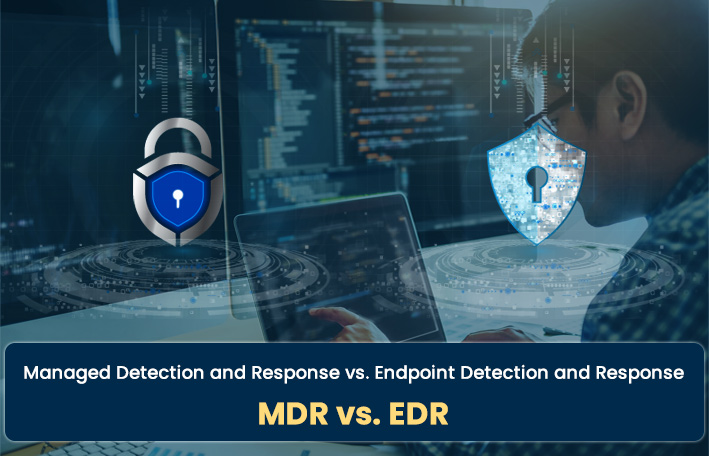
When businesses embark on their journey to build a robust threat detection and response capability, they are faced with a choice: EDR Vs MDR.
As the differences between the two similar-sounding acronyms are very vague, most organizations struggle to determine which solution is best for them.
Here’s a close look at MDR vs EDR to help you better understand what each solution offers:
| Differentiators | MDR (Managed Detection and Response) | EDR (Endpoint Detection and Response) |
| Type | An outsourced security control solution | A set of security tools and capabilities deployed internally |
| Responsibility | Managed Security Service Providers (MSSPs) | Internal security team |
| Area of Focus | Endpoint and network security | Solely on endpoint security |
| Offerings |
|
|
What to Choose: MDR or EDR?
Here are some of the vital factors organizations must consider to determine which of the two options is a better fit for their requirements:
- In-house Security Team
The state of an organization’s internal security talent is a deciding factor in choosing between MDR and EDR. If you have a right sized security team and lack endpoint response tools, EDR is the right choice. However, if you lack critical security talent and expertise, then MDR is a better fit for you.
- Security Posture
If an organization has achieved cybersecurity maturity with limited endpoint security capabilities, then EDR can fill the security gaps. However, if an organization needs an improvement in overall security posture, then MDR is the best option.
- Incident Response
Cyber Incidence Response (CIR) enables organizations to respond quickly to an incident and mitigate the damage. But EDR doesn’t offer this capability, it only supports it. If an organization lacks an in-house CIR team, then MDR service providers like StealthLabs can help you.
By now, you should be possibly determined which of the two options is a better fit for you. However, considering the perilous state of the cyber landscape, it is wise to adopt both MDR and EDR.
StealthLabs As Your MDR Service Provider
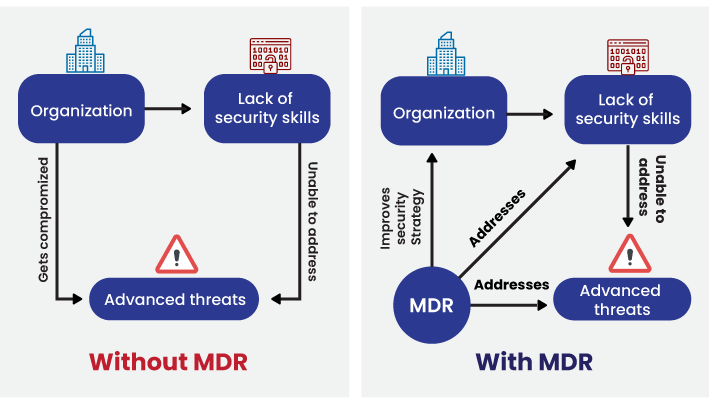
Stealthlabs brings the depth and scale of Managed Detection and Response capabilities to clients through robust cybersecurity capabilities that go beyond simple tech deployment. Our industry-specific experience in security operations and cyber incidence response means we help you solve the complexity of evolving threats and changing business needs.
Reach out to us without further ado for a stitch in time, saves nine. Secure your data and enjoy the benefits of a robust business solution.
More Articles:
- What Skills Should Your IT Security Team Have?
- IT Security Advisory Services Market Poised for 19% CAGR By 2024
- Cybersecurity in Education: 10 Important Facts and Statistics
- 20 Alarming Insider Threats Statistics
- Leading US Gasoline Pipeline Hit By Ransomware Attack, Halts Operations
- Multi-Factor Authentication Implementation, Best Practices and Benefits
- What Skills Should Your IT Security Team Have?

